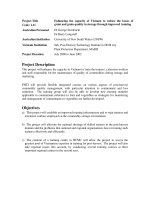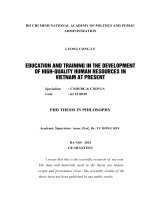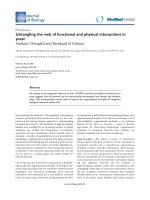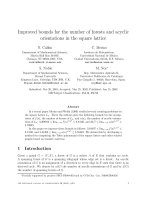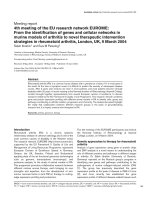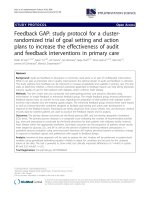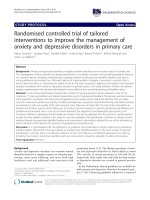The competitiveness of textile and garment industry in vietnam
Bạn đang xem bản rút gọn của tài liệu. Xem và tải ngay bản đầy đủ của tài liệu tại đây (621.08 KB, 94 trang )
國 立 雲 林 科 技 大 學
國 際 企 業 管 理 研 究 所 碩 士 班
碩 士 論 文
越南入世後紡織與成衣產業競爭力研究
The Competitiveness of Textile and Garment
Industry in Vietnam
After Vietnam’s Accession to the WTO
研 究 生:李萬堂
指導教授 : 鍾從定 博士
中華民國 101 年 6 月
越 南 入 世 後 紡 織 與 成 衣 產 業 競 爭 力 研 究
The Competitiveness of Textile and Garment Industry
In Vietnam after Vietnam’s Accession to the WTO
研 究 生:李萬堂 Le Van Dung
指導教授 : 鍾從定博士 Chung, Tsungting Ph.D.
國立雲林科技大學
國際企業管理研究所碩士班
碩士論文
A Thesis
Submitted to
Institution of International Business Administration
National Yunlin University of Science & Technology
in Partial Fulfillment of the Requirements
for the Degree of
Master of Management
In
International Business Administration
June 2012
Douliu, Yunlin, Taiwan, Republic of China
中華民國 101 年 6 月
The Competitiveness of Textile and Garment Industry in Vietnam
After Vietnam’s Accession to the WTO
Student: Le Van Dung
Advisor: Chung, Tsungting Ph.D.
National Yunlin University of Science and Technology
Department of International Business Administration
Master’s Thesis
Abstract
This thesis concentrates on the competitiveness of Vietnam’s textile and garment
industry after Vietnam’s accession to the WTO. The research tries to find out the factors
affect competitiveness of textile and garment industry in Vietnam, the strengths and
weaknesses of the industry, providing both textile and garment management, and
government as policy-makers the best alternative resolutions to strengthen the
competitiveness of textile and garment industry in the future. The literature review
framework about competitiveness and its assessment is based on different theories such
as Porter’s diamond model and Kaplan and Norton’s Balanced Scorecard concept. The
case is analyzed by both primary and secondary data. Primary data includes of
questionnaires that distributed to companies and agencies in Vietnam (most of them in
Northern Vietnam). Last but not least, the thesis concludes that the Vietnam’s textile
and garment industry has competitiveness on three levels consist of nation environment,
industry environment, and firm environment. Nonetheless, the data of thesis is based on
past document and the process of static analysis is subjective, so the results of this case
may not be valuable to all extent of the industry in Vietnam.
5
Key words: Competitiveness, textile and garment industry, WTO, Vietnam
Acknowledgement
First of all, I would like to give my sincerely grateful thanks to my advisor, Prof.
Chung Tsungting for his support, encouragement, enthusiasm and time. He often helps
and provides opportunities to his student. During two years in Taiwan, I learned many
things from his knowledge as well as his experience. From the beginning to the end, he
always gives me a hand in critical moment.
Second, I would like to say thank to my relative who helped me to send
questionnaires to enterprises and agencies. After that he also collected questionnaires
and static data from those.
Next, I am thankful to all professors, lectures, friends and members of my family
who help me, encourage me during my studying time. They always support and make
me feel that I am not alone.
I also would like to thank the Thanh Hoa‘s Overseas Scholarship Program and
Hong Duc University in their financial support so that I could complete master program
and had a good chance to discover the different culture in Taiwan.
Finally I would like to show my thankfulness to those who participated in this
study./.
Le Van Dung
June 2012
6
7
Table of Contents
Abstract…………………………………………………………………………………...i
Acknowledge……………………………………………………………………………..ii
Table of Contents……………………………………………………………...…………iii
List of Appendix………………………………………………………………………….v
List of Tables……………………………………………………………………………..vi
List of Figures…………………………………………………………………………...vii
Glossary of Acronyms ………………………………………………………………….viii
8
List of Appendix
Appendix 1 - Industrial zones of Vietnam ……………………………………....64
Appendix 2 – Questionnaires…………………………………………………….65
9
List of Tables
10
List of Figures
11
Glossary of Acronyms
ATC: Agreement on Textile and Clothing
CSR: Corporate Social Responsibility
EU: European Union
FTA: The free trade agreements
GATT: General Agreement on Tariff and Trade
GSO: General Statistics Office
MFA: Multi-Fiber Agreement
TPP: Trans-Pacific Economic Partnership
VITAS: Vietnam Textile and Apparel Association
WTO: World Trade Organization
12
Chapter 1 Introduction
1.1 Background
The term of competitiveness becomes quite similar with economists, politicians
and decision-makers in economic scale around the world. While competitiveness has
often been the central attention of business enterprises, during long period of time the
word has been progressively used in combination with the economic presentation of
entire industries or nations. In fact, many studies of researchers such as Dwarfs and
Giants Maintaining the Competitive edge: the Italian and Textile Clothing Industry in
1990s of Bulussi, F (1997); Textile and Apparel in the Global Economy of Dickerson,
K (1995); Spatial Clustering and Industrial Competitiveness of Lundequist, P (2002)
make sure and gain comparative advantage at different levels of firm, industry and
nation.
In Vietnam, the concept of competitiveness is also used broadly and highregularly. Particularly, when Vietnam joins in the WTO and further global economic
integration, competition between different regions and diverse industries has become
fiercer and fiercer. In order to obtain a further maintainable improvement of their
economies, the system of government, public organizations and firms are eagerly trying
to analyze and measure competitiveness to find out their weaknesses and strengths.
After searching and consulting relative references, there are two theories include
Diamond model of Porter (1985) and The Balance Scorecard translating Strategy into
Action of Kaplan and Norton (1996) are used to interpret the competitiveness of an
industry and firms. In Vietnam, the textile and garment industry is one of the most
important mainstay industries (the second largest industry after petroleum industry) in
13
my country, is an appropriate research subject aiming at investigating the level of the
competitiveness, strengths and weaknesses by analyzing factors affect to the
development of textile and garment industry in Vietnam.
The competitiveness of Vietnam’s textile and garment industry is analyzed by
using and applying existing model and theory to point out competitive terms and valuate
them by meaning of scoring the factors through testing in a quantitative method, it is
innovative and interesting. Many research articles and papers related to competitiveness
and the textile and garment industry, which will be useful to my research.
1.2 Statement of the Problems
The competitiveness notion in three levels of nation, industry and firm is different,
but the definitions of competitiveness among them are not very clear in some extents
and objectives. There are many theories that can definite the competitiveness at
different levels and its outcome depends on the method used. Thus, when it comes to
the textile and garment cluster in a country, there are no specific theories or models
aimed at finding out its competitiveness even if many researchers and experts have
found many explanatory factors. The problem is whether finding the main factors
influencing the competitiveness of the textile and garment industry from existing
theories and materials, and whether finding or establishing an appropriate strategy for
use to evaluate the field of the Vietnam’s textile and garment industry. Will the result
develop in the thesis have useful suggestion on the whole textile and garment industry
or whole system of government in Vietnam?
14
1.3 Purpose
The purpose of the thesis is to find which factors impact to the competitiveness of
the textile and garment industry in Vietnam by using and applying the appropriate
existing theories to analyze its competitiveness. Therefore, after analyzing the theories,
the factors affect to competitiveness of the textile and garment firms in Vietnam will be
considered following the different environments as external factors and internal factors.
After that the research will point out what factors are its strengths and what factors are
its weaknesses and SWOT analysis is needed to use in this case. Other purposes of the
thesis are to better understand and accumulate the knowledge of how to use these
theories to evaluate the competitiveness at the three levels. Finally, the thesis will put
forward several inferences about how to maintain strong points and improve the
unfavorable aspects in order that the Vietnam’s textile and garment industry will
develop sustainably and long-term in the future.
1.4 Research Questions
1. What are the relevant factors should be considered as competitiveness of textile
and garment industry?
2. How to analyze the competitiveness of the textile and garment industry in
Vietnam?
3. What are the main SWOT analysis of the Vietnam’s textile and garment
industry?
4. How do the textile and garment firms do to improve their competitiveness and
policy of government to support the industry in the future?
15
1.5 Organization of the Study
This thesis is structured in five chapters. The first chapter describes about the
background and statement of problems, objectives, research questions and organization
of this study. The second chapter reviews the underpinning and underlying the theories
from the relevant literature include overviews of Vietnam textile and garment industry
and the role of garment industry. The third chapter focuses on the explanation of the
content of conceptual framework, hypothesis, and the research methodology. The fourth
chapter
targets
the results
of analyses.
recommendations are in chapter five.
16
The conclusions, discussions
and
Chapter 2 Literatures Review
2.1 Competitiveness Assessment
The term “competitiveness” is one of the magic expressions used by economists,
politicians, and business people in different contexts. It can be defined at the level of
nation, industries and individual companies. However, different definitions of
competitiveness need a clear concept of what will be measured and explained.
The nation level, McCulloh (1988) in his working paper – International
competition in service stated that competitiveness as the degree to which an economy,
under a free market regime. It could produce goods and services and that survive the test
international markets, while at the same time maintaining and expanding the real
income level of its citizen.
Industry level is another level were detailed analysis for individual industries
can be studied. In this research, an industry is defined as a group of companies located
in a nation - regardless of ownership - that produce products that are regarded as close
substitutes by consumers. A nation’s industry consists of a group of companies
competing not only among themselves, but also as an aggregate against the same
industries in other countries. Industrial competitiveness is applied in many aspects and
the level of textile and garment industry is considered by the characteristics.
In this level, the competitiveness primarily mentions to overall quality of
17
products or services that is better than similar industries in other countries. It is also
related to total allocations of natural resources, infrastructure and market of a country or
region.
At the level of individual firms, competitiveness is understood as the ability of a
firm to survive and thrive, given the competition of other firms for the same profits. It
means that the competitiveness is the result of a competitive advantage relative to other
firms. Porter (1985) defined competitive advantage as the ability of a company to make
products that provide more value to the customer than rival products, leading to higher
sales and higher profits for that company. However, the concept has a restriction is that
competitors will be quick and easy to copy either the products or production processes
to make profits and catch up with a firm.
Markusen (1992) defined competitiveness as the ability of the firm to gain and
sustain a level of productivity that is equal to or higher than level accomplished by
competitors. In addition, in term of cost of competitiveness defined as the ability of firm
to produce and market product at equal or lower unit costs relative to that of
competitors.
Besides three competitiveness levels that mentions earlier, The Global
Competitiveness Report 2010-2011 of World Economic Forum defines competitiveness
is “the set of institutions, policies, and factors that determine the level of productivity of
a country” (p4). The level of productivity, in turn, sets the sustainable level of
prosperity that can be earned by an economy. In other words, more competitive
economies tend to be able to produce higher levels of income for their citizens. The
productivity level also determines the rates of return obtained by investments (physical,
18
human, and technological) in an economy. Because the rates of return are the
fundamental drivers of the growth rates of the economy, a more competitive economy is
one that is likely to grow faster in the medium to long run.
In order to understand the definition clearly and practicably, there are different
aspects of competitiveness are generated. These components are grouped into 12 pillars
of economic competitiveness as follow Table 2.1.
Table 2.1 The twelve Pillars in three Groups
Group
Basic requirements
Pillars
• Institutions
• Infrastructure
• Macroeconomic environment
• Health and primary education
Efficiency enhancers
• Higher education and training
• Goods market efficiency
• Labor market efficiency
• Financial market development
• Technological readiness
• Market size
19
Innovation and
sophistication factors
• Business sophistication
• Innovation
Source: The Global Competitiveness Report 2010-2011 © 2010 World Economic
Forum
2.2 The Factors Affect to the Competitiveness of Textile and Garment
Industry.
The identification of factors influence to the competitiveness is so essential to a
firm when shaping a competitive strategy. This research will classify factors into
external factors and internal factors over which external factors are terms relate to
nation and industry environment. Meanwhile, internal factors are terms relate to firm
environment. All of external factors constitute source of opportunities and threats for a
company, and firm factors are the source of strengths and weaknesses of the enterprise.
2.2.1 Nation Environment
In general, a company’s nation environment contains all related factors and
influences outside of the company’s boundaries and they are essential enough to have a
bearing on the final decisions of the company about its direction, objectives, strategies,
and business models.
Nation environment factors concern to PEST analysis that terms relate to political
changes, economy changes, social factors and technological changes in a country or
region. First of all, political factors can be defined the legal and regulatory parameters
20
such as government budget balance, national saving rate, government debt and stable
political regime. Second perspective is the nature of economy in which a firm operates,
it includes such terms as obtainability of credit, the level of disposable income, interest
rate spread, inflation rate, and the propensity of people to spend. Then, social factors
comprise of the beliefs, values, attitudes, opinions, and lifestyles in the firm
environment as develop cultural, religious, educational, and ethnic condition. Another
perspective associates with technological factors such as technological changes and
promoting innovation. In addition, ecological factors is also important aspect relates to
nation environment, consist of specific concerns regarding air, water, land pollution,
global warming, loss of habitat, and biodiversity.
However, in shape of the research only mentions to some main indicators that the
most possibly impact to textile and garment industry such as economic growth, interest
rate, inflation rate, technology transfer, stable political regime, and environmental
issues.
2.2.2 Industry Environment
According to Porter (1990) used two factors to value competitiveness: First one
comes from the nation where the industry/firm exist so-called national competitive
advantage and another one is ability of industry or firm to process the nation
environment through competitive strategy. He also classified these factors into four
broad attributes - diamond model: (1) factor conditions; (2) demand conditions; (3)
related and supporting industries; (4) firm’s strategy, structure, and rivalry. Moreover,
there are two factors more - the chance and government that are linked through above
21
four factors and cannot be ignored. Analysis on the factors reveals that why some
industries are more competitive than others within a nation or other countries. So-called
Porter’s Diamond Theory as illustrate following figure:
Figure 2.1 Porter’s Diamond Theory
Source: Adapted from Porter.E (1990)
Factors conditions are elements that similar to standard economy theory such as
human resources, natural resources, knowledge resources, capital resources and
infrastructure. These general factors lead to firms have competitive advantages to other
competitors. A firm located in a certain region or country need to know which factor is
weak, which one is strong to build a appreciate strategy overcome the shortages.
For instance, in order to resolve problems of labor shortage in watch industry,
Switzerland concentrated on innovative and high-end market. In Japan, land is limited
22
for manufacturing, so this led to just-in-time inventory techniques focus on high quality
electronic and car such as Sony, Panasonic, Toyota, Honda, and so on.
Demand conditions: Porter (1990) stated that demand is shaped by three features
including their mixture - the mix of customer needs and wants, their scope and growth
rate, and the mechanisms that transmit domestic preferences to foreign market. Basing
on the characteristics, a firm will understand customer’s needs and desires better. In
other word, industrial advantage need a more demanding local market that help local
firms take part in global trends.
Related and supporting industries: According to Porter, industries that are strong
related and supporting is important to the competitiveness of firms. This is because they
can supply important inputs and services for the innovation and commercialization of
firms in the sector. They can also interact together to make close working relationships
and through the relationships, firms can gain a quick and easy access to new
technologies, new ideas and related information.
According to Singleton (1997), the most important things relate and support to the
textile and garment industries are the production of machinery, materials the fashion
sector and relevant services and facilities. Rather, the benefits of clustering arise from
opportunities for cooperation between firms engaging in related activities. Cooperation
among these industries is an important factor to support textile and garment industry
and enhance the competitiveness.
Firm strategy, structure and rivalry: In order to improve competitiveness, firms
need to base on each factor of firm strategy, structure and rivalry to create and establish
their objectives and type of administration which is indispensable for their success.
23
Basing on this model, detail industry environment factors are pointed out as
Appendix 2 (questionnaires).
2.2.3 The Firm Environment
The level of firm is the last of three abroad competitive sources. From this level, a
company can identify the strengths and the weaknesses in order to shape an appropriate
strategy. There are some approaches to assess company’s competitiveness and one of
them is Balanced-Scorecard method.
This theory was published firstly by Kaplan and Norton in 1996 and its model has
become an alternative of outcome measure and performance driver.
24
Figure 2.2 The Balanced Scorecard translating Strategy into Action
Source: Kaplan and Norton. (1996). Balanced Scorecard: Translating Strategy into
Action.
Following this model, a framework for strategic management is outlined into an
integrated collection of objectives and the performance of terms that separated into four
perspectives: financial, customer, internal business process, and learning and growth.
25


